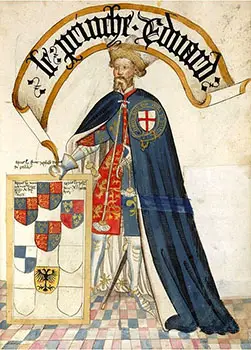Edward The Black Prince
Edward of Woodstock or Edward the Black Prince was an English prince and son of King Edward III and his wife Philippa Hainault. He was also the father of King Richard II. Edward is popular in history for his military acumen and achievements.
His victories against French in Battle of Crecy and Battle of Poitiers are stuff of legends. These victories made him a much adored and respected figure even during his life. He was heir apparent and Prince of Wales till his untimely death in 1376. Edward’s title ‘The Black Prince’ was not used in his life.
There is no clear evidence to suggest the background of this name but many believe that the name referred to Edward’s black shield and body armor. However, a section of historians also contend that the name was a reference to his cruelty against the French people.


Early Life: Edward was born on 15 June, 1330 at Woodstock Palace in Oxfordshire. He was appointed as First Duke of Cornwall in 1337 and in 1343 was appointed as Prince of Wales, a title given to the heir apparent of a British monarch since 13th century.
Thereafter he acted as symbolic regent a number of times when his father Edward III was away on military campaigns. Edward was raised with his cousin Joan, known as ‘The Fair Maid of Kent’. He later married her after seeking permission from Pope Innocent VI in 1361. His marriage to his cousin was not well received among the power circles as it was thought that a marriage in a foreign royal family would have been more beneficial politically.
Edward was appointed as King’s representative in Aquitane, where he and his wife kept a court. His court was attended by a number of exiled monarchs like James IV of Majorca and Peter of Castile.
Military Career and Achievements: Edward was known as an excellent military commander. His achievements in battlefield and acts of chivalry are a part of folklore. He inflicted crushing defeats upon French in Battle of Crecy in 1346 and Poitiers in 1356.
In the Crecy campaign, Normandy was invaded by English. He thereafter headed to the northern France and laid siege to Calais. In 1350, Edward fought and won a major naval battle against a Castilian fleet in the English Channel. This battle is known as Battle of Winchelsea. He also secured several victories during the Aquitaine campaign, in which large tracts of land were invaded in southern France. In 1367, Edward fought the Battle of Najera on behalf of his friend Peter of Castile.
He defeated Peter’s brother, Henry of Trastamara and restored Peter to the throne. The Black Prince was also hailed for display of chivalry towards his defeated foes. In one particular instance, he after defeating French king, John the Good treated him and his son well. He also allowed John to return home. However, some historians believe that his tactics of plundering and burning invaded towns and villages was against the spirit of chivalry.

Later Life and Death: Edward suffered from poor health in the last years of his life. It is said that his health remained good till 1366, when he was on a campaign to restore Pedro the Cruel to the Castilian throne.
According to common belief, In the Castilian campaign, Edward’s army was severely hit by dysentery and he also contracted the disease. He then continued to be bothered by ill health till his death in 1376. His frail health made it difficult for him to participate in battles. However, in 1370 he had to lead an effort to defend his holdings in Aquitaine against Charles V of France, despite his frail health.
His health deteriorated continuously until his death in 1376 at the age of forty five. He was buried in Canterbury Cathedral in Kent. His son Richard II succeeded Edward’s father as the King of England.




